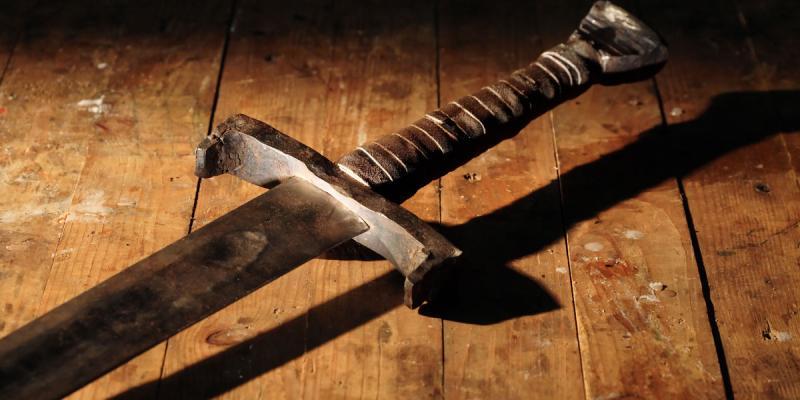You are here
Book of Mormon Central is in the process of migrating to our new Scripture Central website.
We ask for your patience during this transition. Over the coming weeks, all pages of bookofmormoncentral.org will be redirected to their corresponding page on scripturecentral.org, resulting in minimal disruption.
Concerning his encounter with Laban, who was an important official in Jerusalem around 600 B.C., Nephi stated, “I beheld his sword, and I drew it forth from the sheath thereof; and the hilt thereof was of pure gold, and the workmanship thereof was exceedingly fine, and I saw that the blade thereof was of the most precious steel” (1 Nephi 4:9). Nephi’s description of this weapon was long considered anachronistic because it makes reference to steel long before it was thought to have existed in ancient times.1
In recent decades, however, scholars have learned that ancient Near Eastern blacksmiths and metallurgists were “intentionally steeling iron” through a process of deliberate carburization hundreds of years before Nephi’s day.2 Early evidence that various tools, axes, and knife blades, were made from iron hardened into steel has been found throughout the ancient Near East dating between the thirteenth to the tenth centuries BC.3
Archaeologists have now recovered not only tools but also rare examples of steel swords from the ancient Near East. Such ancient swords were unknown at the time the Book of Mormon was published.4 Even more significant, perhaps, in relation to the sword of Laban, is the fact that archaeologists have discovered a carburized iron sword near Jericho, only about 12 miles east of Jerusalem. The sword, which had a bronze haft, was a meter long and dates to the time of King Josiah, a contemporary of Lehi. This particular find is noteworthy since it is apparently “the only complete sword of its size and type from this period yet discovered in Israel.”5 According to Avraham Eitan, “Metallurgical analysis of a sample taken from the blade proves … that the iron was deliberately hardened into steel, attesting to the technical knowledge of the blacksmith.”6Today the sword is displayed at Jerusalem's Israel Museum.
Such discoveries lend a great sense of historicity and credibility to Nephi’s deliberate comment in the Book of Mormon.
- 1. “This is the earliest account of steel to be found in history.” E. D. Howe, Mormonism Unvailed (1834), 25–26. “Laban’s sword was steel, when it is a notorious fact that the Israelites knew nothing of steel for hundreds of years afterwards. Who but as ignorant a person as Rigdon would have perpetrated all these blunders?” Clark Braden in Public Discussion, 1884, 109. “Laban is represented as killed by one Nephi, some six hundred years before Christ, with a sword ‘of the most precious steel,’ hundreds of years before steel was known to man!” Daniel Bartlett, The Mormons or, Latter-day Saints (1911), 15. “[The Book of Mormon] speaks of the most ‘precious steel,’ before the commonest had been dreamt of.” C. Sheridan Jones, The Truth about the Mormons (1920), 4–5. “Nephi . . . wielded a sword ‘of the most precious steel.’ But steel was not known to man in those days.” Stuart Martin, The Mystery of Mormonism (1920), 44. “Laban had a steel sword long before steel came into use.” George Arbaugh, Revelation in Mormonism (1932), 55. “Every commentator on the Book of Mormon has pointed out the many cultural and historical anachronisms, such as the steel sword of Laban in 600 B.C.” Thomas O’Dea, The Mormons (1957), 39. “No one believes that steel was available to Laban or anyone else in 592 B.C.” William Whalen, The Latter-day Saints in the Modern World (1964), 48.
- 2. Robert Maddin, James D. Muhly and Tamara S. Wheeler, “How the Iron Age Began,” Scientific American 237, no. 4 (October 1977): 127. “Wrought iron heated in contact with hot charcoal (Carbon) at high temperatures produces carbonized iron or steel which is more malleable than cast iron.” Philip J. King and Lawrence E. Stager, Life in Biblical Israel (Louisville, KY: Westminster John Knox Press, 2001), 169. The process of steeling iron in the ancient Near East is explained in James D. Muhly, “Mining and Metalwork in Ancient Western Asia,” in Civilizations of the Ancient Near East, 4 vols., ed. Jack M. Sasson (New York, NY: Charles Scribner’s Sons, 1995), 3:1515.
- 3. See Erik Tholander, “Evidence of the Use of Carburized Steel and Quench Hardening in Late Bronze Age Cyprus,” Opuscula Atheniensia 10 (1971): 15–22; Anthony M. Snodgrass, “Iron and Early Metallurgy in the Mediterranean,” in The Coming Age of Iron, ed. Theodore A. Wertime and James D. Muhly (New Haven and London: Yale University Press, 1980), 341, 365–366; D. Davis, R. Maddin, J.D. Muhly, T. Stech, “A Steel Pick from Mt. Adir in Palestine,” Journal of Near Eastern Studies 4 (1985): 41–51; Amihai Mazar, Archaeology of the Land of the Bible 10,000–586 B.C.E. (New York, NY: Doubleday, 1990), 361.
- 4. Herbert Maryon, “Early Near Eastern Steel Swords,” American Journal of Archaeology 65, no. 2 (1961): 173–184.
- 5. Hershall Shanks, “Antiquities director confronts problems and controversies,” Biblical Archaeology Review 12, no. 4 (1986): 33, 35.
- 6. Avraham Eitan, “Rare Sword of the Israelite Period Found at Vered Jericho,” Israel Museum Journal 12 (1994): 62.
Further Reading
Book of Mormon Central, “What Was the Sword of Laban Like?” KnoWhy 401 (January 23, 2018).
“Iron Sword, Small Silver Scroll from Lehi’s Day Discovered,” Insights: An Ancient Window 6, no. 2 (1986): 1.
“Iron Sword from the Times of Jeremiah Discovered Near Jericho,” Ensign, June 1987, 57.
William J. Hamblin and A. Brent Merrill, “Swords in the Book of Mormon,” in Warfare in the Book of Mormon, ed. Stephen D. Ricks and William J. Hamblin (Salt Lake City, UT: Deseret Book, 1990), 329–351.
William J. Adams Jr., “Nephi’s Jerusalem and Laban’s Sword,” Journal of Book of Mormon Studies 2, no. 2 (1993): 194–195.
Matthew Roper, “Swords and Cimeters in the Book of Mormon,” Journal of Book of Mormon Studies 8, no. 1 (1999): 34–43.



